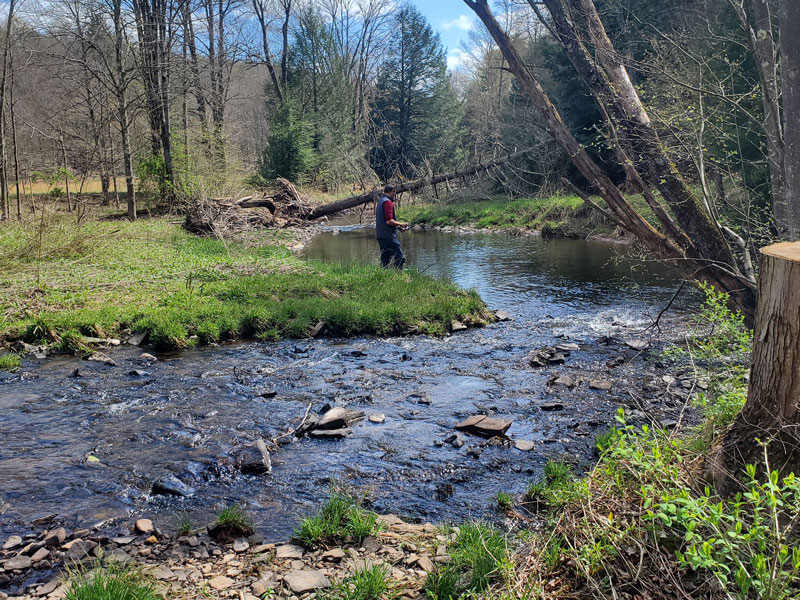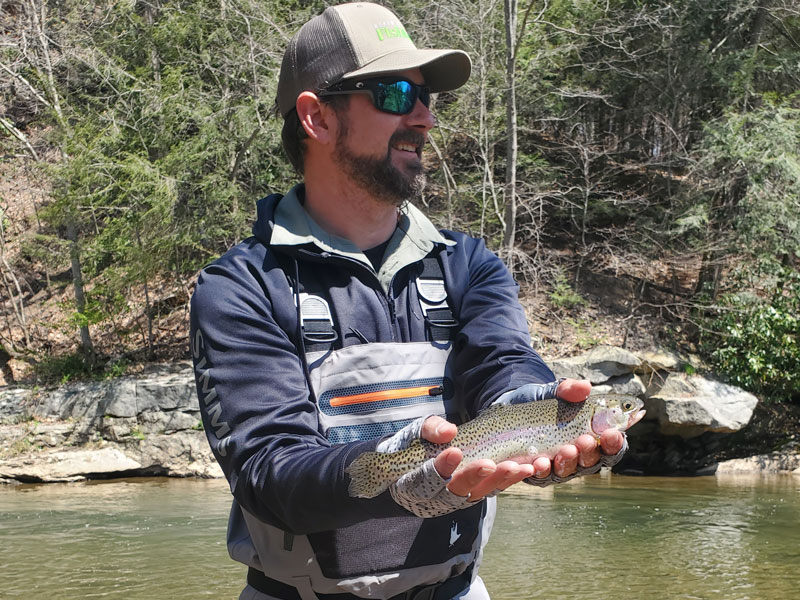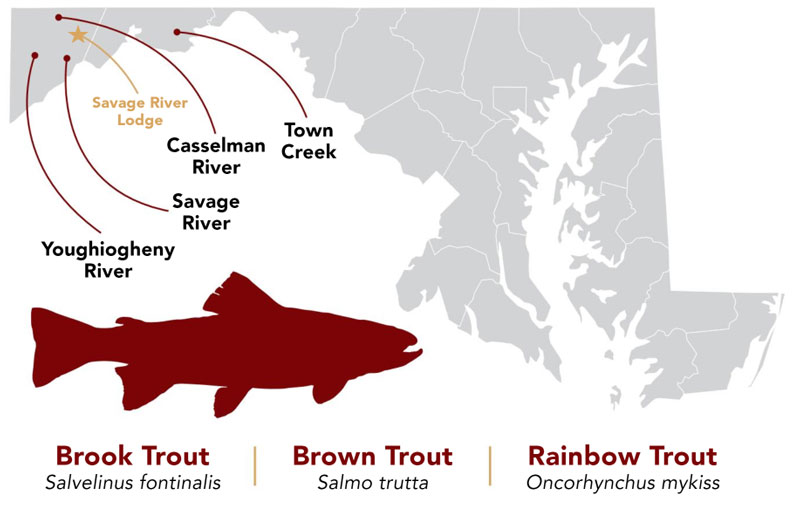In Part 1 of our "Gone Fishin'" A Maryland Road Trip" we met with the crew from Fish & Hunt Maryland in Cambridge to see if we could snag some snakeheads. Here in Part 2, we traveled to Western Maryland for a fly fishing adventure. Be sure to check out Part 3 where we visit Ocean City in search of clams and flounder.
I’ll be the first to admit it: when it comes to fishing for rainbow trout I’m utterly incompetent with a fly rod in my hands. I tried fly fishing back in my 20s and quickly came to admire the artistic side of this endeavor, but eventually concluded that it wouldn’t be my prime modus operandi. I don’t think this decision had anything to do with the fact that the first time I tried practice-casting my new fly rod, I swung the tip into an overhead powerline and snapped off six inches of graphite. Nor do I blame the time I back-cast a Wooly Bugger into my right ear. Or when I discovered that performing a solid strip-set into a stump while holding a fly rod 90 degrees to the side in a canoe creates enough off-center force to roll it. So, when the Fish & Hunt Maryland guys said they wanted to go fly fishing, I began to sweat…
Opportunity Knocks
Truth be told, we have some fantastic fly fishing opportunities to enjoy in the state of Maryland. You can begin the famed statewide Fly Fishing Trail casting streamers to stripers on the Bay, the very next day use the buggy whip for bass in an Eastern Shore millpond, and the day after that roll-cast for rainbows in a mountain river. You’ll have just begun exploring the options as you follow in the footsteps of fly fishing legends like Lefty Kreh, Joe Brooks, and George Gains, all members of the Southern Fly Fishing Hall of Fame and all native Marylanders.

Our particular adventure would have us heading out to western Maryland to target rainbow trout in the riffles and pools of the Casselman River. And mercifully for this nymphing neophyte, we’d be fishing with Mike Dreisbach, an owner of Savage River Lodge and a fly fishing guide and teacher with decades of experience.
We arrived at the lodge on the early side, chomping at the bit to wet a line. Rather than settle into our yurts (permanent tents with wood frames surrounded by insulated canvas), we opted to grab some rods and head for the headwaters of the Savage River. While the section of river running along the lodge’s property is almost small enough to jump across at points, it’s home to a population of native brook trout. These small but gorgeous fish are known for their wary nature and picky feeding habits — something I learned about firsthand, watching slack-jawed as the only brookie spotted that afternoon, a six-incher, wildly darted off from under the riverbank at Mach I.
Brook Trout or Bust
Native brook trout may be minor league in the size department, but they’re just as challenging to catch as the biggest fish in the ocean. Garrett County has the highest density of brook trout in Maryland, and you can find plenty of places with good populations that can be publicly accessed via the DNR’s Public Angler Access Map. Should you accept the mission of catching one, remember:
- These fish are uber-spooky. Walk quietly, stay low, and dress in drab clothing. If they see you before you see them, it’s game over.
- Fish in an upstream direction. The trout will be facing the current, so when you approach from a downstream direction there’s less likelihood they’ll see you.
- Stick with light leader (5x is about as heavy as you want) and very small offerings, like #8 to #12 wooly buggers or #14 to #18 nymphs.
Checkmate
During dinner back at the lodge (the bacon-wrapped wild game meatloaf is insanely good), in my mind’s eye I replayed watching that 12- to 14-inch wild fish dart off into another time zone approximately 4632 times. Deep breaths. Tomorrow is a new day, and on the Casselman I WILL prevail. Sure, I’m completely out of my usual angling element. Yes, I’m most comfortable fishing when my brain is around six feet above sea level, not 2506 feet. It’s true, I haven’t caught a rainbow trout in a mountain stream in 20-plus years. But with a little advice from Mike (and a pair of the lodge’s waders and boots) I’m sure I can make it happen.
After a good night’s sleep in the yurt — which, incidentally, is nicer inside than 99 percent of the hotel rooms I’ve slept in — some French-pressed coffee, and a luscious lemony poppy-seed muffin, I’m ready to roll. I link up with FishTalk’s resident kayak fishing guru and production manager Zach Ditmars and the Fish & Hunt Maryland crew (Ben and Paul) and we head for a stretch of the Casselman where in 1755 a young military aid named George Washington forded the river with Braddock’s army during the French and Indian War. The four of us donned waders and followed Mike to a deep pool in the river where he confidently predicted rainbow trout would be waiting.

I’d rather not relate what happened next. In all fairness I should mention that Paul had the hot hand, landing two trout plus a fallfish. And I should say that Zach caught a rainbow, broke off another, and landed a fallfish as well. But exactly what I personally may or may not have hooked, reeled in, and landed shall remain (ahem) a mystery.
Rallying for Rainbow Trout
As we found and as Mike confirmed, the stages of the rainbow trout bite depend a great deal on insect hatches. When we began fishing temperatures were in the 40s, there was no hatch to speak of, and the fish weren’t in an eating mood. When it warmed into the upper 40s the bugs began doing their thing, and like magic we saw fish suddenly rising to the surface. For the next 45 minutes or so there was constant action. Well, at least for some of us. Matching the hatch became not just a saying but a necessity, and after the first trout was landed we huddled around and inspected the nymph that had done the trick. One smart angler immediately switched to a similar-looking fly and enjoyed success, while one pigheaded, stuck-in-the-mud angler kept casting his favorite because it was his favorite. And he-who-shall-not-be-named was rewarded accordingly. If you go after rainbows in the Casselman or any other of Maryland’s clear-running trout rivers, remember:
- Match the hatch. Look for insects and rising fish, and choose flies accordingly. When you’re unable to get bites where there are fish, switch offerings until you find one that interests them.
- When the bugs are inactive and you don’t see fish rising, look for holes and deep areas and rig up something that gets down in the water column a bit like a nymph rig weighted with a split shot.
- Use current to your advantage. You can try to fight it all day long, but you can also use it to carry your offering into the strike zone. Cast directly at a fish in a strong current and your fly might be five feet past the fish in a second. But if you cast five feet up-current of the fish and let the moving water do the work you can float that fly right by the fish’s nose.
- Practice ahead of time and hit the river with a skill for casting accuracy and setting the hook already established. Spend some time at a local pond or lake fishing for easy targets like sunfish, and work on it until you can drop an ant between two tree branches.

Trout Fishing Travel
If you want to get started on the western portion of the Fly Fishing Trail, you can attempt this endeavor on your own or enlist the services of a guide, as we did. Either way can be a ball, though we’ll note that beginners such as myself can expect a much greater chance of success with the help of a pro.
Savage River Lodge is a great jumping-off point and everything you could possibly want for stays both short and extended are on-site, ranging from a bar and restaurant to your own personal yurt or cabin. There are also plenty of hotels and restaurants in Cumberland, the largest city in western Maryland. Frostburg, Oakland, and Friendsville have nearby accommodations as well, and there’s a cluster of hotels and restaurants as well as a robust selection of vacation rentals around Deep Creek Lake and McHenry, MD.
Western Maryland Fly Fishing Hotspots

When prospecting for hotspots following the Fly Fishing Trail is a good bet. The site just below Savage River Dam offers good access and is known for holding plenty of brown trout, thanks to the steady flow of cool water. Hatches are constant, with blue quills, sulphurs, and caddis flies considered must-have offerings. The Savage is consistently ranked among the top 100 trout rivers in the United States, but is also known for having wary, suspicious fish, so stay quiet and move slowly.
The Upper Savage above the reservoir is a prime destination thanks to its healthy brook trout population. You’ll find yourself battling overhanging trees and thick cover, but this is some of the top brookie water on the East Coast. It’s also possible to disappear into the wilderness here and fish all day in peaceful, secluded surroundings where few others tread. Hike away from the access points and the farther you go, the better the chances you’ll cast all day long without crossing paths with another angler.
Running through the state’s westernmost portion, the Youghiogheny is a relatively large river filled with a mix of browns and rainbows. A trail runs along the “special regulation” section making for very easy access, and there are plenty of other access points as well. Note that this river runs through the popular Swallow Falls State Park (including Muddy Creek Falls, the highest free-falling waterfall in Maryland), which is a sight not to be missed. If you’re going to be in the area, make sure to plan in an afternoon to check it out.
Town Creek, running into the Potomac River just east of Cumberland, is a top bet for stocked rainbows with a big bonus: plenty of voracious smallmouth bass live here, too. The creek is relatively small but thoroughly secluded and with some hiking it’s easy to find peaceful fishing spots all of your own.
~ By Lenny Rudow
Visit Fish & Hunt Maryland for more information on these sections of the Fly Fishing Trail, how to get there, access points, parking areas, and fishing tips.
Check out Part One of our Gone Fishin' Road Trip as we head to Cambridge on Maryland's Eastern Shore to search for northern snakeheads.